Frankenstein or The Modern Prometheus - PDF
VerifiedAdded on 2021/05/31
|10
|2907
|397
AI Summary
Contribute Materials
Your contribution can guide someone’s learning journey. Share your
documents today.
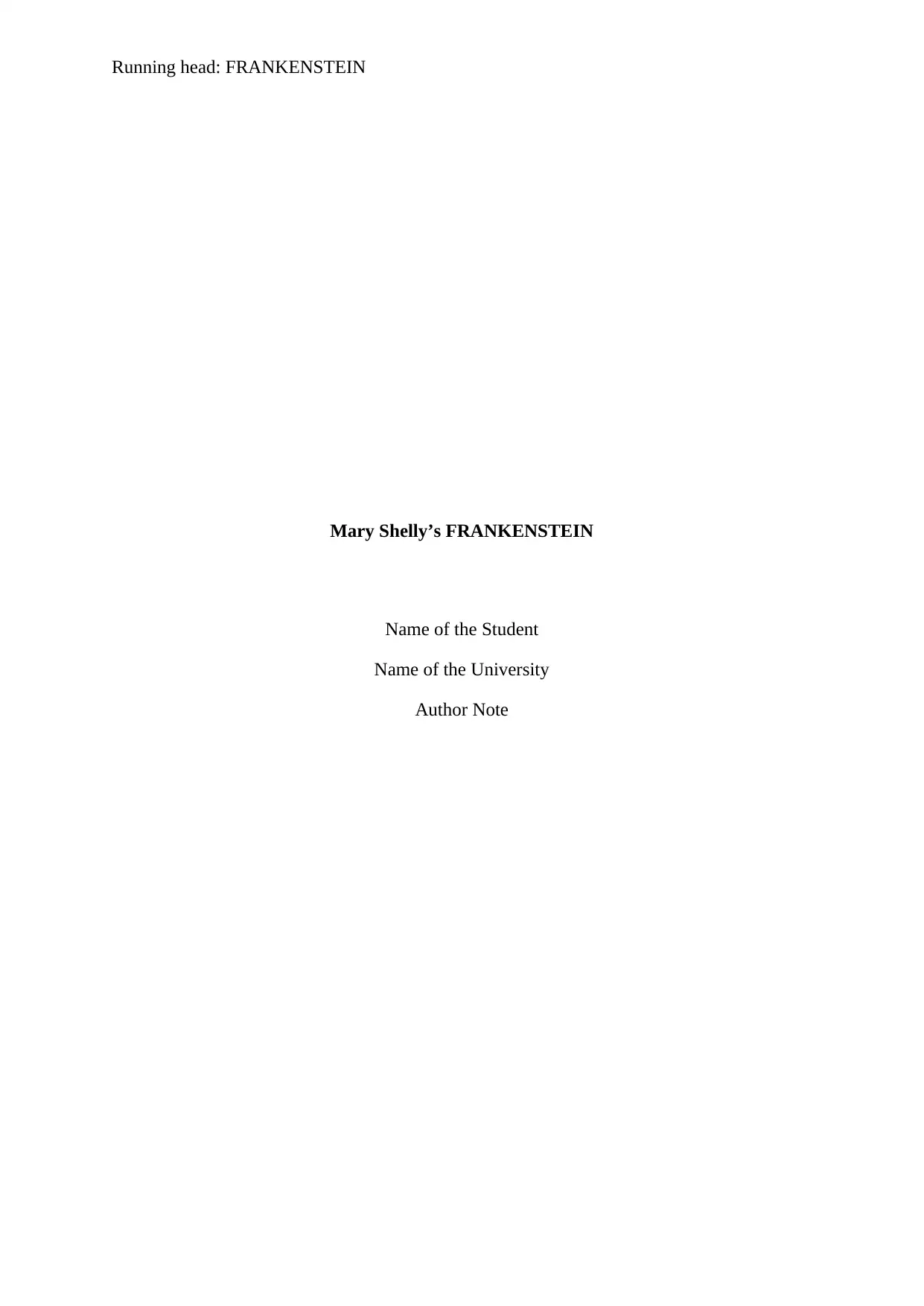
Running head: FRANKENSTEIN
Mary Shelly’s FRANKENSTEIN
Name of the Student
Name of the University
Author Note
Mary Shelly’s FRANKENSTEIN
Name of the Student
Name of the University
Author Note
Secure Best Marks with AI Grader
Need help grading? Try our AI Grader for instant feedback on your assignments.
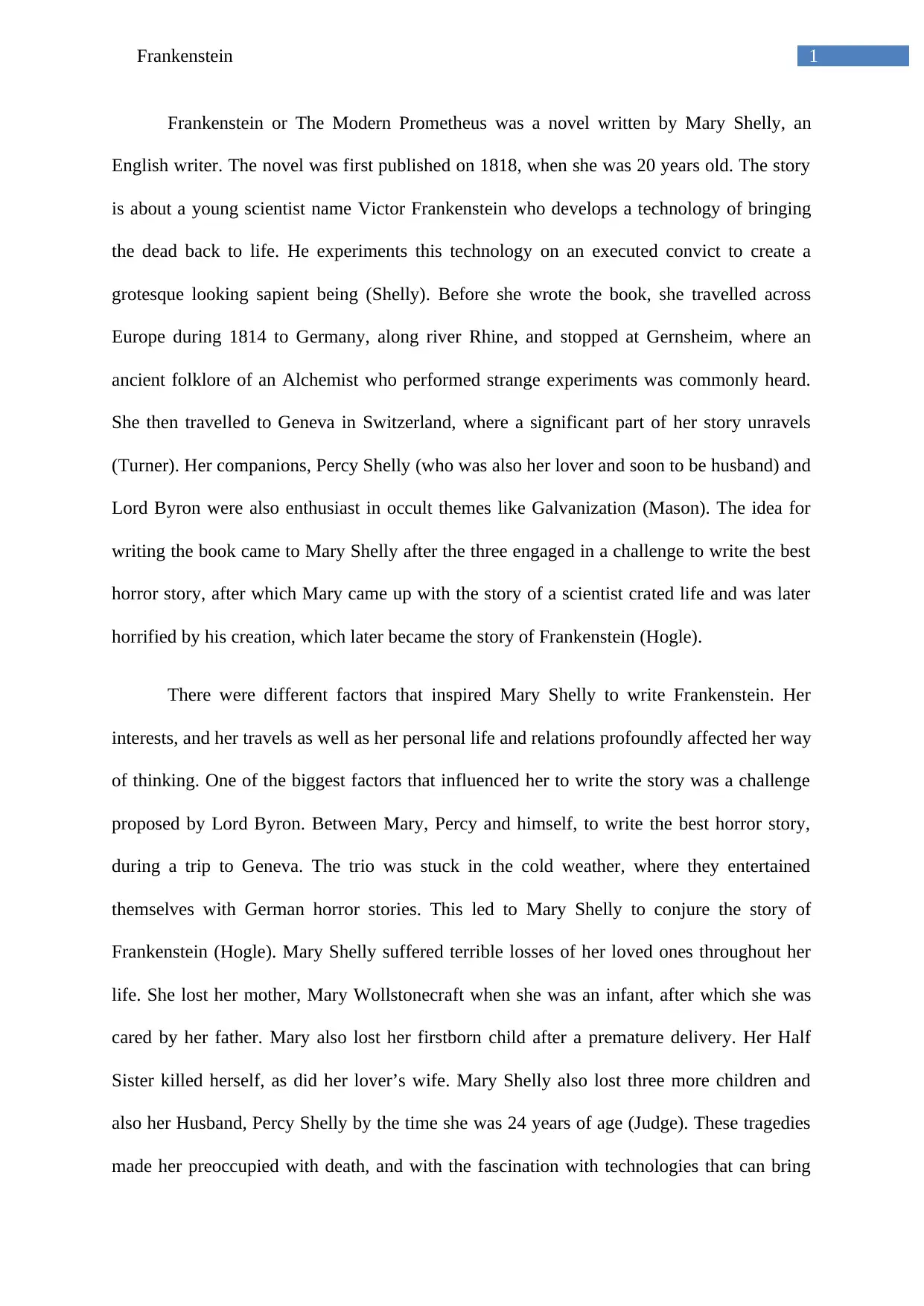
1Frankenstein
Frankenstein or The Modern Prometheus was a novel written by Mary Shelly, an
English writer. The novel was first published on 1818, when she was 20 years old. The story
is about a young scientist name Victor Frankenstein who develops a technology of bringing
the dead back to life. He experiments this technology on an executed convict to create a
grotesque looking sapient being (Shelly). Before she wrote the book, she travelled across
Europe during 1814 to Germany, along river Rhine, and stopped at Gernsheim, where an
ancient folklore of an Alchemist who performed strange experiments was commonly heard.
She then travelled to Geneva in Switzerland, where a significant part of her story unravels
(Turner). Her companions, Percy Shelly (who was also her lover and soon to be husband) and
Lord Byron were also enthusiast in occult themes like Galvanization (Mason). The idea for
writing the book came to Mary Shelly after the three engaged in a challenge to write the best
horror story, after which Mary came up with the story of a scientist crated life and was later
horrified by his creation, which later became the story of Frankenstein (Hogle).
There were different factors that inspired Mary Shelly to write Frankenstein. Her
interests, and her travels as well as her personal life and relations profoundly affected her way
of thinking. One of the biggest factors that influenced her to write the story was a challenge
proposed by Lord Byron. Between Mary, Percy and himself, to write the best horror story,
during a trip to Geneva. The trio was stuck in the cold weather, where they entertained
themselves with German horror stories. This led to Mary Shelly to conjure the story of
Frankenstein (Hogle). Mary Shelly suffered terrible losses of her loved ones throughout her
life. She lost her mother, Mary Wollstonecraft when she was an infant, after which she was
cared by her father. Mary also lost her firstborn child after a premature delivery. Her Half
Sister killed herself, as did her lover’s wife. Mary Shelly also lost three more children and
also her Husband, Percy Shelly by the time she was 24 years of age (Judge). These tragedies
made her preoccupied with death, and with the fascination with technologies that can bring
Frankenstein or The Modern Prometheus was a novel written by Mary Shelly, an
English writer. The novel was first published on 1818, when she was 20 years old. The story
is about a young scientist name Victor Frankenstein who develops a technology of bringing
the dead back to life. He experiments this technology on an executed convict to create a
grotesque looking sapient being (Shelly). Before she wrote the book, she travelled across
Europe during 1814 to Germany, along river Rhine, and stopped at Gernsheim, where an
ancient folklore of an Alchemist who performed strange experiments was commonly heard.
She then travelled to Geneva in Switzerland, where a significant part of her story unravels
(Turner). Her companions, Percy Shelly (who was also her lover and soon to be husband) and
Lord Byron were also enthusiast in occult themes like Galvanization (Mason). The idea for
writing the book came to Mary Shelly after the three engaged in a challenge to write the best
horror story, after which Mary came up with the story of a scientist crated life and was later
horrified by his creation, which later became the story of Frankenstein (Hogle).
There were different factors that inspired Mary Shelly to write Frankenstein. Her
interests, and her travels as well as her personal life and relations profoundly affected her way
of thinking. One of the biggest factors that influenced her to write the story was a challenge
proposed by Lord Byron. Between Mary, Percy and himself, to write the best horror story,
during a trip to Geneva. The trio was stuck in the cold weather, where they entertained
themselves with German horror stories. This led to Mary Shelly to conjure the story of
Frankenstein (Hogle). Mary Shelly suffered terrible losses of her loved ones throughout her
life. She lost her mother, Mary Wollstonecraft when she was an infant, after which she was
cared by her father. Mary also lost her firstborn child after a premature delivery. Her Half
Sister killed herself, as did her lover’s wife. Mary Shelly also lost three more children and
also her Husband, Percy Shelly by the time she was 24 years of age (Judge). These tragedies
made her preoccupied with death, and with the fascination with technologies that can bring
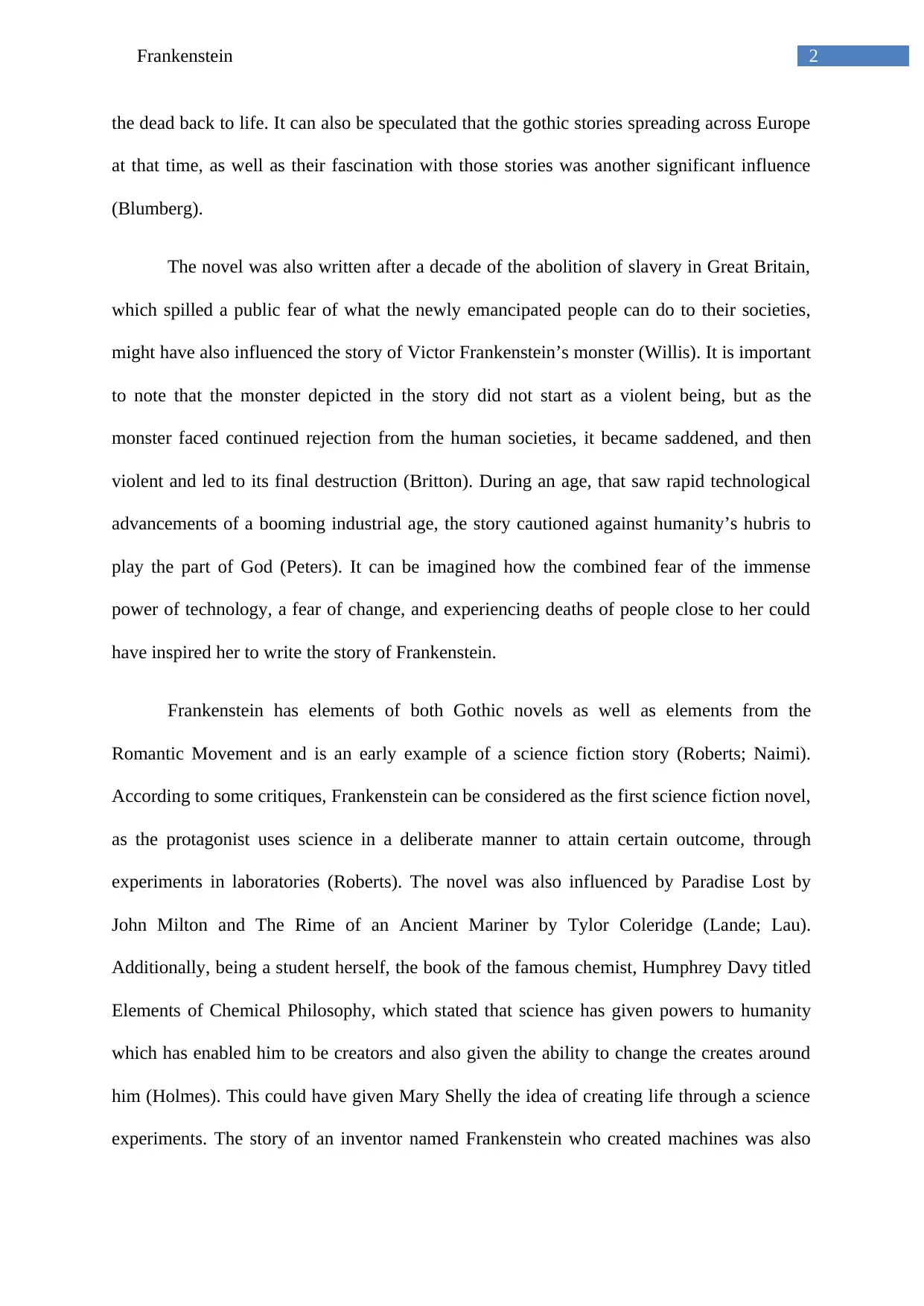
2Frankenstein
the dead back to life. It can also be speculated that the gothic stories spreading across Europe
at that time, as well as their fascination with those stories was another significant influence
(Blumberg).
The novel was also written after a decade of the abolition of slavery in Great Britain,
which spilled a public fear of what the newly emancipated people can do to their societies,
might have also influenced the story of Victor Frankenstein’s monster (Willis). It is important
to note that the monster depicted in the story did not start as a violent being, but as the
monster faced continued rejection from the human societies, it became saddened, and then
violent and led to its final destruction (Britton). During an age, that saw rapid technological
advancements of a booming industrial age, the story cautioned against humanity’s hubris to
play the part of God (Peters). It can be imagined how the combined fear of the immense
power of technology, a fear of change, and experiencing deaths of people close to her could
have inspired her to write the story of Frankenstein.
Frankenstein has elements of both Gothic novels as well as elements from the
Romantic Movement and is an early example of a science fiction story (Roberts; Naimi).
According to some critiques, Frankenstein can be considered as the first science fiction novel,
as the protagonist uses science in a deliberate manner to attain certain outcome, through
experiments in laboratories (Roberts). The novel was also influenced by Paradise Lost by
John Milton and The Rime of an Ancient Mariner by Tylor Coleridge (Lande; Lau).
Additionally, being a student herself, the book of the famous chemist, Humphrey Davy titled
Elements of Chemical Philosophy, which stated that science has given powers to humanity
which has enabled him to be creators and also given the ability to change the creates around
him (Holmes). This could have given Mary Shelly the idea of creating life through a science
experiments. The story of an inventor named Frankenstein who created machines was also
the dead back to life. It can also be speculated that the gothic stories spreading across Europe
at that time, as well as their fascination with those stories was another significant influence
(Blumberg).
The novel was also written after a decade of the abolition of slavery in Great Britain,
which spilled a public fear of what the newly emancipated people can do to their societies,
might have also influenced the story of Victor Frankenstein’s monster (Willis). It is important
to note that the monster depicted in the story did not start as a violent being, but as the
monster faced continued rejection from the human societies, it became saddened, and then
violent and led to its final destruction (Britton). During an age, that saw rapid technological
advancements of a booming industrial age, the story cautioned against humanity’s hubris to
play the part of God (Peters). It can be imagined how the combined fear of the immense
power of technology, a fear of change, and experiencing deaths of people close to her could
have inspired her to write the story of Frankenstein.
Frankenstein has elements of both Gothic novels as well as elements from the
Romantic Movement and is an early example of a science fiction story (Roberts; Naimi).
According to some critiques, Frankenstein can be considered as the first science fiction novel,
as the protagonist uses science in a deliberate manner to attain certain outcome, through
experiments in laboratories (Roberts). The novel was also influenced by Paradise Lost by
John Milton and The Rime of an Ancient Mariner by Tylor Coleridge (Lande; Lau).
Additionally, being a student herself, the book of the famous chemist, Humphrey Davy titled
Elements of Chemical Philosophy, which stated that science has given powers to humanity
which has enabled him to be creators and also given the ability to change the creates around
him (Holmes). This could have given Mary Shelly the idea of creating life through a science
experiments. The story of an inventor named Frankenstein who created machines was also
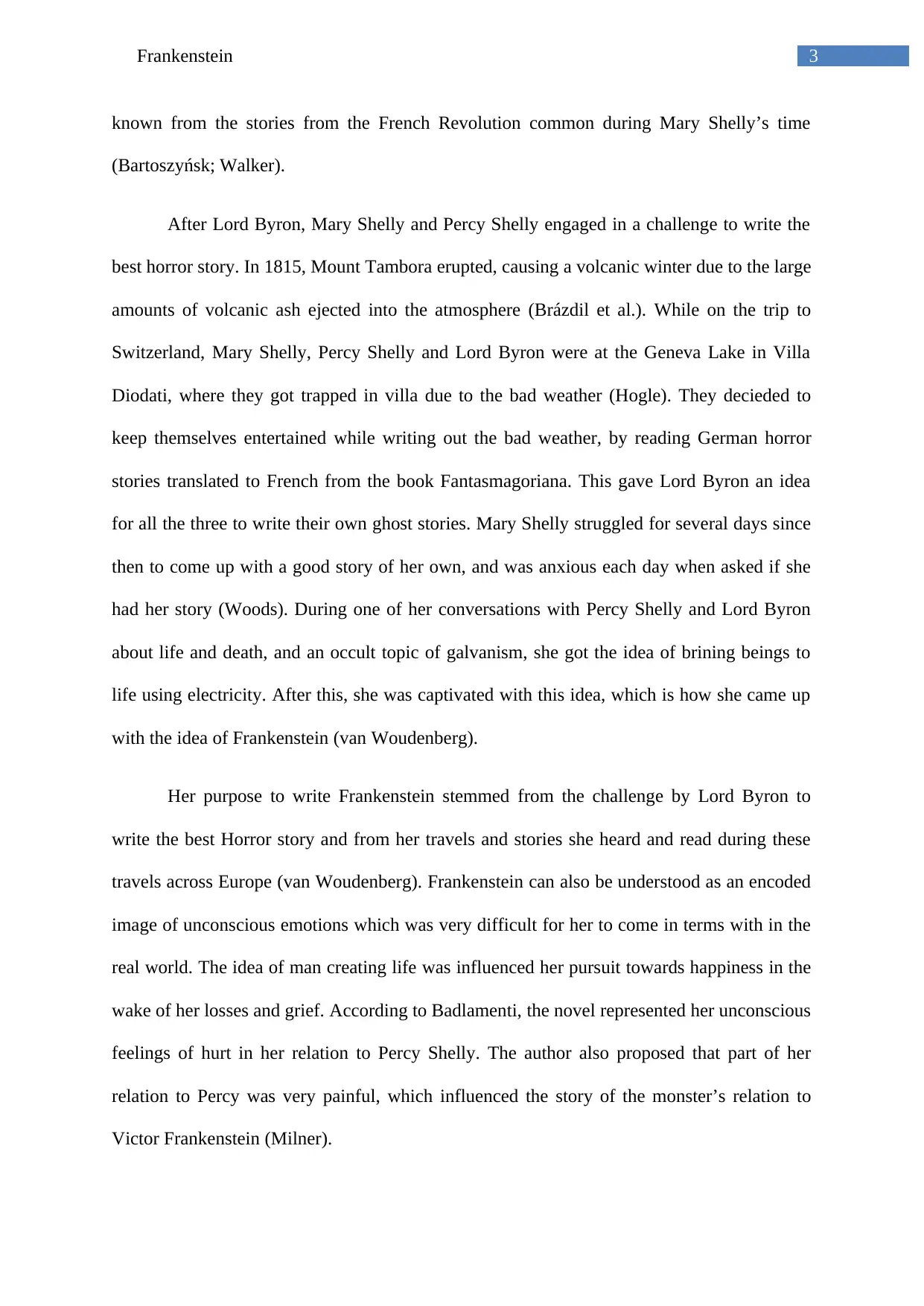
3Frankenstein
known from the stories from the French Revolution common during Mary Shelly’s time
(Bartoszyńsk; Walker).
After Lord Byron, Mary Shelly and Percy Shelly engaged in a challenge to write the
best horror story. In 1815, Mount Tambora erupted, causing a volcanic winter due to the large
amounts of volcanic ash ejected into the atmosphere (Brázdil et al.). While on the trip to
Switzerland, Mary Shelly, Percy Shelly and Lord Byron were at the Geneva Lake in Villa
Diodati, where they got trapped in villa due to the bad weather (Hogle). They decieded to
keep themselves entertained while writing out the bad weather, by reading German horror
stories translated to French from the book Fantasmagoriana. This gave Lord Byron an idea
for all the three to write their own ghost stories. Mary Shelly struggled for several days since
then to come up with a good story of her own, and was anxious each day when asked if she
had her story (Woods). During one of her conversations with Percy Shelly and Lord Byron
about life and death, and an occult topic of galvanism, she got the idea of brining beings to
life using electricity. After this, she was captivated with this idea, which is how she came up
with the idea of Frankenstein (van Woudenberg).
Her purpose to write Frankenstein stemmed from the challenge by Lord Byron to
write the best Horror story and from her travels and stories she heard and read during these
travels across Europe (van Woudenberg). Frankenstein can also be understood as an encoded
image of unconscious emotions which was very difficult for her to come in terms with in the
real world. The idea of man creating life was influenced her pursuit towards happiness in the
wake of her losses and grief. According to Badlamenti, the novel represented her unconscious
feelings of hurt in her relation to Percy Shelly. The author also proposed that part of her
relation to Percy was very painful, which influenced the story of the monster’s relation to
Victor Frankenstein (Milner).
known from the stories from the French Revolution common during Mary Shelly’s time
(Bartoszyńsk; Walker).
After Lord Byron, Mary Shelly and Percy Shelly engaged in a challenge to write the
best horror story. In 1815, Mount Tambora erupted, causing a volcanic winter due to the large
amounts of volcanic ash ejected into the atmosphere (Brázdil et al.). While on the trip to
Switzerland, Mary Shelly, Percy Shelly and Lord Byron were at the Geneva Lake in Villa
Diodati, where they got trapped in villa due to the bad weather (Hogle). They decieded to
keep themselves entertained while writing out the bad weather, by reading German horror
stories translated to French from the book Fantasmagoriana. This gave Lord Byron an idea
for all the three to write their own ghost stories. Mary Shelly struggled for several days since
then to come up with a good story of her own, and was anxious each day when asked if she
had her story (Woods). During one of her conversations with Percy Shelly and Lord Byron
about life and death, and an occult topic of galvanism, she got the idea of brining beings to
life using electricity. After this, she was captivated with this idea, which is how she came up
with the idea of Frankenstein (van Woudenberg).
Her purpose to write Frankenstein stemmed from the challenge by Lord Byron to
write the best Horror story and from her travels and stories she heard and read during these
travels across Europe (van Woudenberg). Frankenstein can also be understood as an encoded
image of unconscious emotions which was very difficult for her to come in terms with in the
real world. The idea of man creating life was influenced her pursuit towards happiness in the
wake of her losses and grief. According to Badlamenti, the novel represented her unconscious
feelings of hurt in her relation to Percy Shelly. The author also proposed that part of her
relation to Percy was very painful, which influenced the story of the monster’s relation to
Victor Frankenstein (Milner).
Secure Best Marks with AI Grader
Need help grading? Try our AI Grader for instant feedback on your assignments.
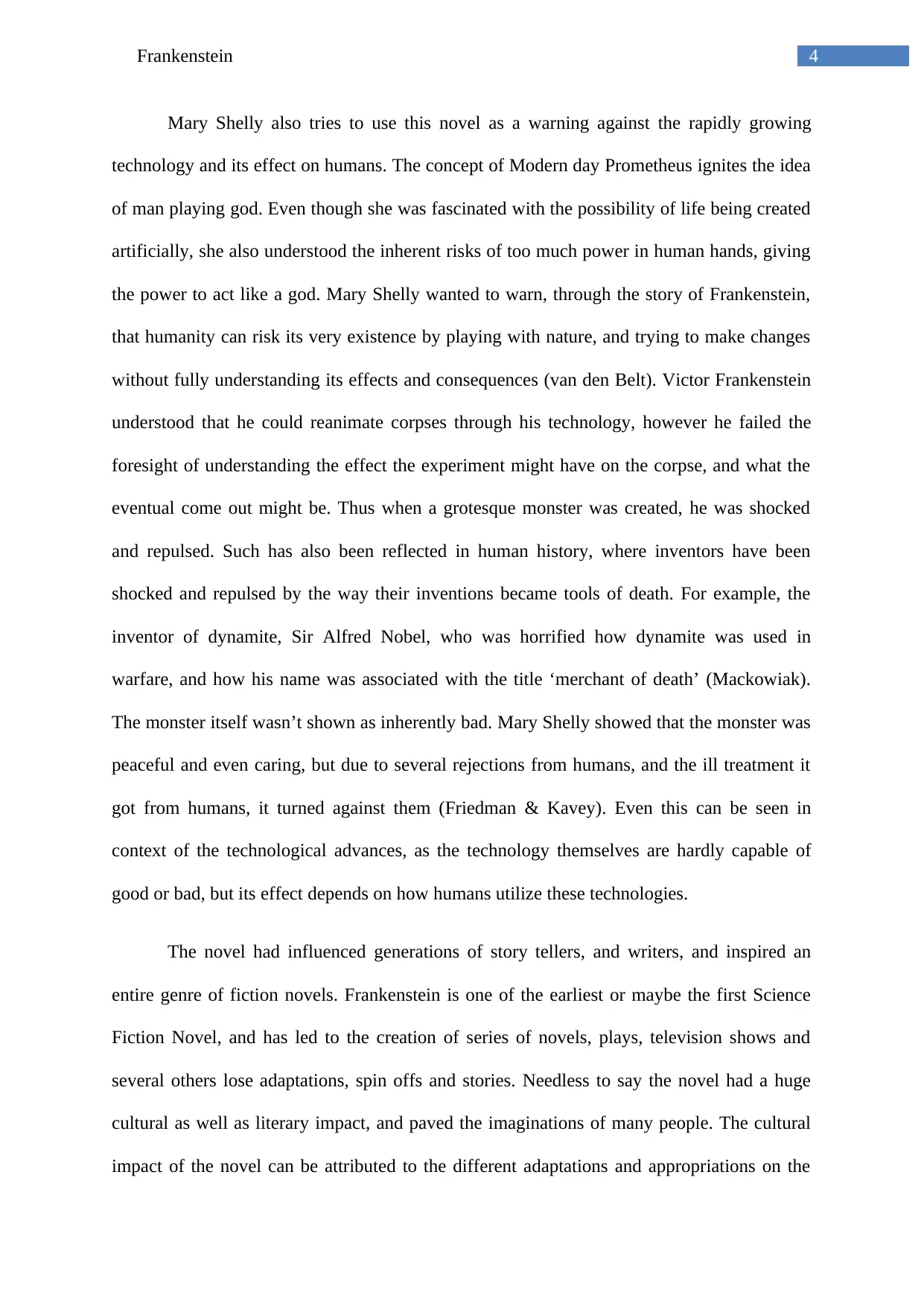
4Frankenstein
Mary Shelly also tries to use this novel as a warning against the rapidly growing
technology and its effect on humans. The concept of Modern day Prometheus ignites the idea
of man playing god. Even though she was fascinated with the possibility of life being created
artificially, she also understood the inherent risks of too much power in human hands, giving
the power to act like a god. Mary Shelly wanted to warn, through the story of Frankenstein,
that humanity can risk its very existence by playing with nature, and trying to make changes
without fully understanding its effects and consequences (van den Belt). Victor Frankenstein
understood that he could reanimate corpses through his technology, however he failed the
foresight of understanding the effect the experiment might have on the corpse, and what the
eventual come out might be. Thus when a grotesque monster was created, he was shocked
and repulsed. Such has also been reflected in human history, where inventors have been
shocked and repulsed by the way their inventions became tools of death. For example, the
inventor of dynamite, Sir Alfred Nobel, who was horrified how dynamite was used in
warfare, and how his name was associated with the title ‘merchant of death’ (Mackowiak).
The monster itself wasn’t shown as inherently bad. Mary Shelly showed that the monster was
peaceful and even caring, but due to several rejections from humans, and the ill treatment it
got from humans, it turned against them (Friedman & Kavey). Even this can be seen in
context of the technological advances, as the technology themselves are hardly capable of
good or bad, but its effect depends on how humans utilize these technologies.
The novel had influenced generations of story tellers, and writers, and inspired an
entire genre of fiction novels. Frankenstein is one of the earliest or maybe the first Science
Fiction Novel, and has led to the creation of series of novels, plays, television shows and
several others lose adaptations, spin offs and stories. Needless to say the novel had a huge
cultural as well as literary impact, and paved the imaginations of many people. The cultural
impact of the novel can be attributed to the different adaptations and appropriations on the
Mary Shelly also tries to use this novel as a warning against the rapidly growing
technology and its effect on humans. The concept of Modern day Prometheus ignites the idea
of man playing god. Even though she was fascinated with the possibility of life being created
artificially, she also understood the inherent risks of too much power in human hands, giving
the power to act like a god. Mary Shelly wanted to warn, through the story of Frankenstein,
that humanity can risk its very existence by playing with nature, and trying to make changes
without fully understanding its effects and consequences (van den Belt). Victor Frankenstein
understood that he could reanimate corpses through his technology, however he failed the
foresight of understanding the effect the experiment might have on the corpse, and what the
eventual come out might be. Thus when a grotesque monster was created, he was shocked
and repulsed. Such has also been reflected in human history, where inventors have been
shocked and repulsed by the way their inventions became tools of death. For example, the
inventor of dynamite, Sir Alfred Nobel, who was horrified how dynamite was used in
warfare, and how his name was associated with the title ‘merchant of death’ (Mackowiak).
The monster itself wasn’t shown as inherently bad. Mary Shelly showed that the monster was
peaceful and even caring, but due to several rejections from humans, and the ill treatment it
got from humans, it turned against them (Friedman & Kavey). Even this can be seen in
context of the technological advances, as the technology themselves are hardly capable of
good or bad, but its effect depends on how humans utilize these technologies.
The novel had influenced generations of story tellers, and writers, and inspired an
entire genre of fiction novels. Frankenstein is one of the earliest or maybe the first Science
Fiction Novel, and has led to the creation of series of novels, plays, television shows and
several others lose adaptations, spin offs and stories. Needless to say the novel had a huge
cultural as well as literary impact, and paved the imaginations of many people. The cultural
impact of the novel can be attributed to the different adaptations and appropriations on the
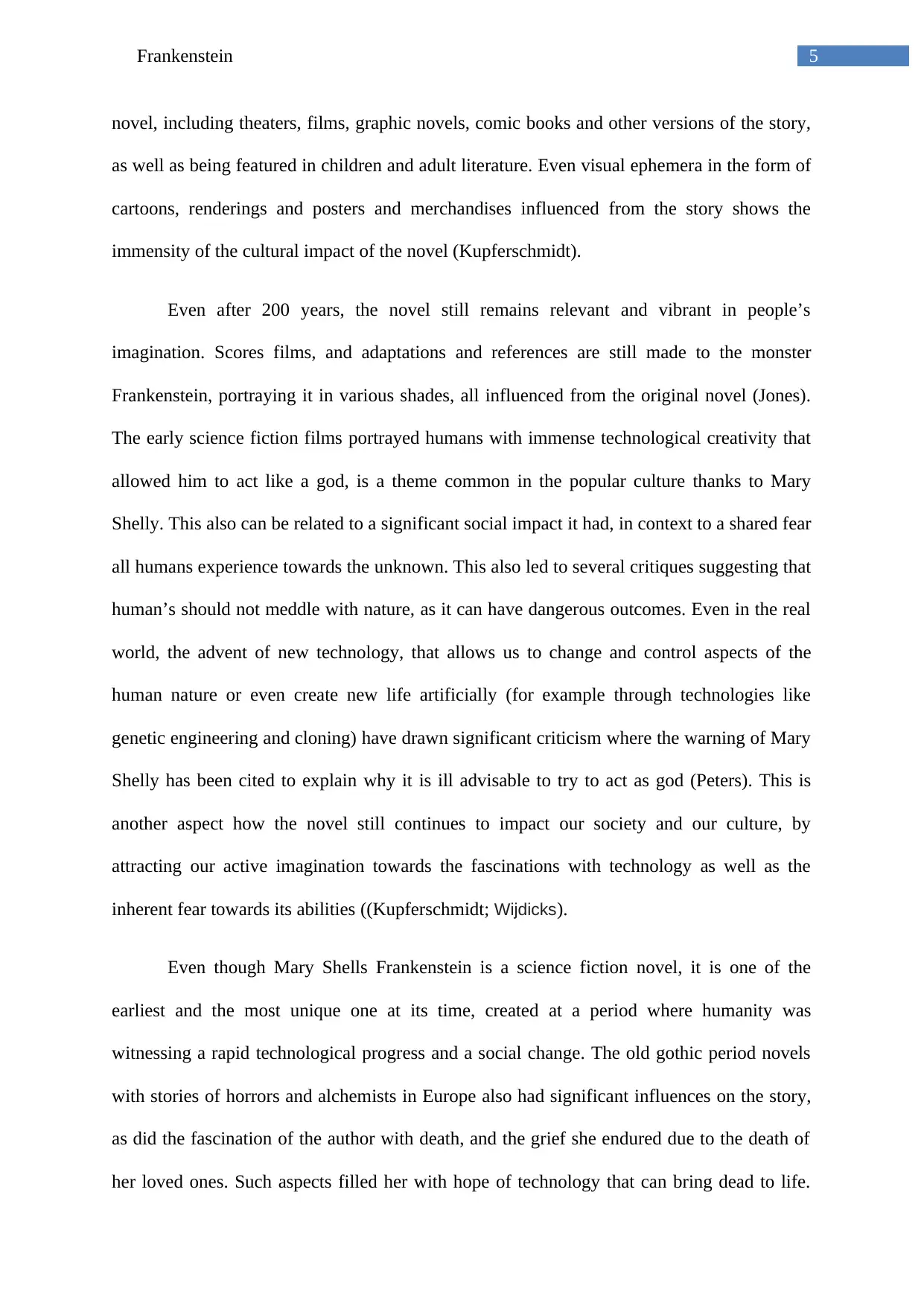
5Frankenstein
novel, including theaters, films, graphic novels, comic books and other versions of the story,
as well as being featured in children and adult literature. Even visual ephemera in the form of
cartoons, renderings and posters and merchandises influenced from the story shows the
immensity of the cultural impact of the novel (Kupferschmidt).
Even after 200 years, the novel still remains relevant and vibrant in people’s
imagination. Scores films, and adaptations and references are still made to the monster
Frankenstein, portraying it in various shades, all influenced from the original novel (Jones).
The early science fiction films portrayed humans with immense technological creativity that
allowed him to act like a god, is a theme common in the popular culture thanks to Mary
Shelly. This also can be related to a significant social impact it had, in context to a shared fear
all humans experience towards the unknown. This also led to several critiques suggesting that
human’s should not meddle with nature, as it can have dangerous outcomes. Even in the real
world, the advent of new technology, that allows us to change and control aspects of the
human nature or even create new life artificially (for example through technologies like
genetic engineering and cloning) have drawn significant criticism where the warning of Mary
Shelly has been cited to explain why it is ill advisable to try to act as god (Peters). This is
another aspect how the novel still continues to impact our society and our culture, by
attracting our active imagination towards the fascinations with technology as well as the
inherent fear towards its abilities ((Kupferschmidt; Wijdicks).
Even though Mary Shells Frankenstein is a science fiction novel, it is one of the
earliest and the most unique one at its time, created at a period where humanity was
witnessing a rapid technological progress and a social change. The old gothic period novels
with stories of horrors and alchemists in Europe also had significant influences on the story,
as did the fascination of the author with death, and the grief she endured due to the death of
her loved ones. Such aspects filled her with hope of technology that can bring dead to life.
novel, including theaters, films, graphic novels, comic books and other versions of the story,
as well as being featured in children and adult literature. Even visual ephemera in the form of
cartoons, renderings and posters and merchandises influenced from the story shows the
immensity of the cultural impact of the novel (Kupferschmidt).
Even after 200 years, the novel still remains relevant and vibrant in people’s
imagination. Scores films, and adaptations and references are still made to the monster
Frankenstein, portraying it in various shades, all influenced from the original novel (Jones).
The early science fiction films portrayed humans with immense technological creativity that
allowed him to act like a god, is a theme common in the popular culture thanks to Mary
Shelly. This also can be related to a significant social impact it had, in context to a shared fear
all humans experience towards the unknown. This also led to several critiques suggesting that
human’s should not meddle with nature, as it can have dangerous outcomes. Even in the real
world, the advent of new technology, that allows us to change and control aspects of the
human nature or even create new life artificially (for example through technologies like
genetic engineering and cloning) have drawn significant criticism where the warning of Mary
Shelly has been cited to explain why it is ill advisable to try to act as god (Peters). This is
another aspect how the novel still continues to impact our society and our culture, by
attracting our active imagination towards the fascinations with technology as well as the
inherent fear towards its abilities ((Kupferschmidt; Wijdicks).
Even though Mary Shells Frankenstein is a science fiction novel, it is one of the
earliest and the most unique one at its time, created at a period where humanity was
witnessing a rapid technological progress and a social change. The old gothic period novels
with stories of horrors and alchemists in Europe also had significant influences on the story,
as did the fascination of the author with death, and the grief she endured due to the death of
her loved ones. Such aspects filled her with hope of technology that can bring dead to life.
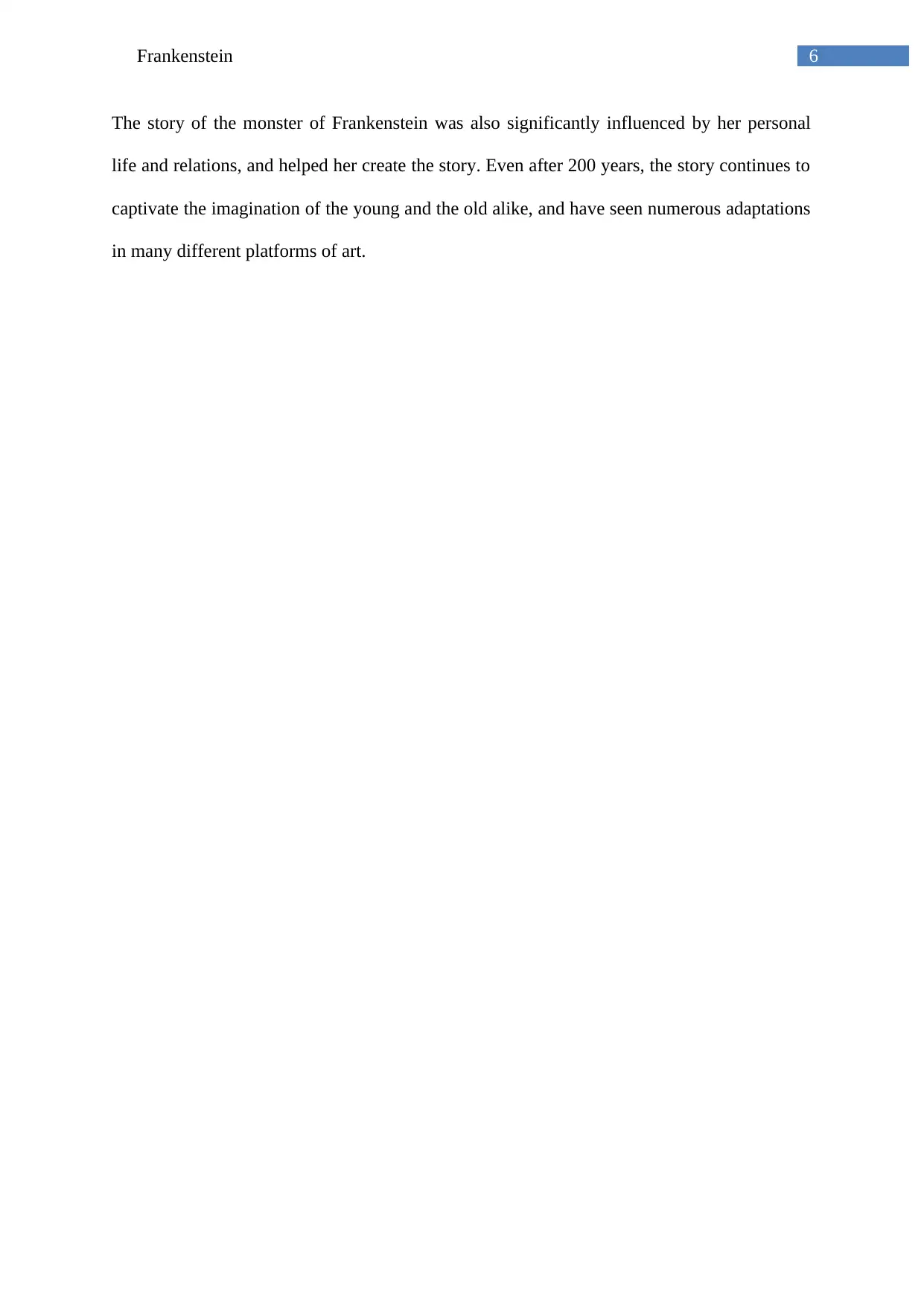
6Frankenstein
The story of the monster of Frankenstein was also significantly influenced by her personal
life and relations, and helped her create the story. Even after 200 years, the story continues to
captivate the imagination of the young and the old alike, and have seen numerous adaptations
in many different platforms of art.
The story of the monster of Frankenstein was also significantly influenced by her personal
life and relations, and helped her create the story. Even after 200 years, the story continues to
captivate the imagination of the young and the old alike, and have seen numerous adaptations
in many different platforms of art.
Paraphrase This Document
Need a fresh take? Get an instant paraphrase of this document with our AI Paraphraser
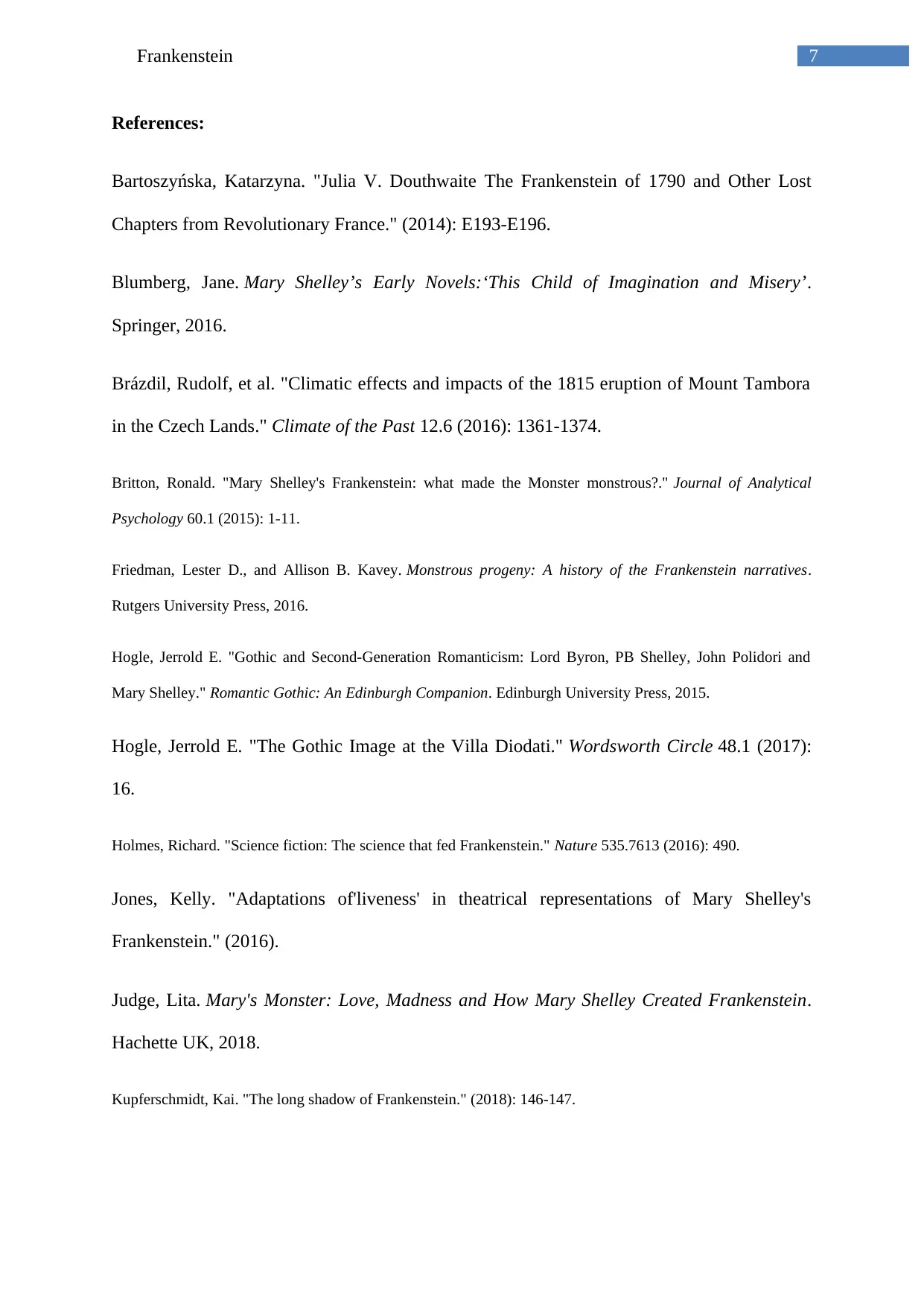
7Frankenstein
References:
Bartoszyńska, Katarzyna. "Julia V. Douthwaite The Frankenstein of 1790 and Other Lost
Chapters from Revolutionary France." (2014): E193-E196.
Blumberg, Jane. Mary Shelley’s Early Novels:‘This Child of Imagination and Misery’.
Springer, 2016.
Brázdil, Rudolf, et al. "Climatic effects and impacts of the 1815 eruption of Mount Tambora
in the Czech Lands." Climate of the Past 12.6 (2016): 1361-1374.
Britton, Ronald. "Mary Shelley's Frankenstein: what made the Monster monstrous?." Journal of Analytical
Psychology 60.1 (2015): 1-11.
Friedman, Lester D., and Allison B. Kavey. Monstrous progeny: A history of the Frankenstein narratives.
Rutgers University Press, 2016.
Hogle, Jerrold E. "Gothic and Second-Generation Romanticism: Lord Byron, PB Shelley, John Polidori and
Mary Shelley." Romantic Gothic: An Edinburgh Companion. Edinburgh University Press, 2015.
Hogle, Jerrold E. "The Gothic Image at the Villa Diodati." Wordsworth Circle 48.1 (2017):
16.
Holmes, Richard. "Science fiction: The science that fed Frankenstein." Nature 535.7613 (2016): 490.
Jones, Kelly. "Adaptations of'liveness' in theatrical representations of Mary Shelley's
Frankenstein." (2016).
Judge, Lita. Mary's Monster: Love, Madness and How Mary Shelley Created Frankenstein.
Hachette UK, 2018.
Kupferschmidt, Kai. "The long shadow of Frankenstein." (2018): 146-147.
References:
Bartoszyńska, Katarzyna. "Julia V. Douthwaite The Frankenstein of 1790 and Other Lost
Chapters from Revolutionary France." (2014): E193-E196.
Blumberg, Jane. Mary Shelley’s Early Novels:‘This Child of Imagination and Misery’.
Springer, 2016.
Brázdil, Rudolf, et al. "Climatic effects and impacts of the 1815 eruption of Mount Tambora
in the Czech Lands." Climate of the Past 12.6 (2016): 1361-1374.
Britton, Ronald. "Mary Shelley's Frankenstein: what made the Monster monstrous?." Journal of Analytical
Psychology 60.1 (2015): 1-11.
Friedman, Lester D., and Allison B. Kavey. Monstrous progeny: A history of the Frankenstein narratives.
Rutgers University Press, 2016.
Hogle, Jerrold E. "Gothic and Second-Generation Romanticism: Lord Byron, PB Shelley, John Polidori and
Mary Shelley." Romantic Gothic: An Edinburgh Companion. Edinburgh University Press, 2015.
Hogle, Jerrold E. "The Gothic Image at the Villa Diodati." Wordsworth Circle 48.1 (2017):
16.
Holmes, Richard. "Science fiction: The science that fed Frankenstein." Nature 535.7613 (2016): 490.
Jones, Kelly. "Adaptations of'liveness' in theatrical representations of Mary Shelley's
Frankenstein." (2016).
Judge, Lita. Mary's Monster: Love, Madness and How Mary Shelley Created Frankenstein.
Hachette UK, 2018.
Kupferschmidt, Kai. "The long shadow of Frankenstein." (2018): 146-147.
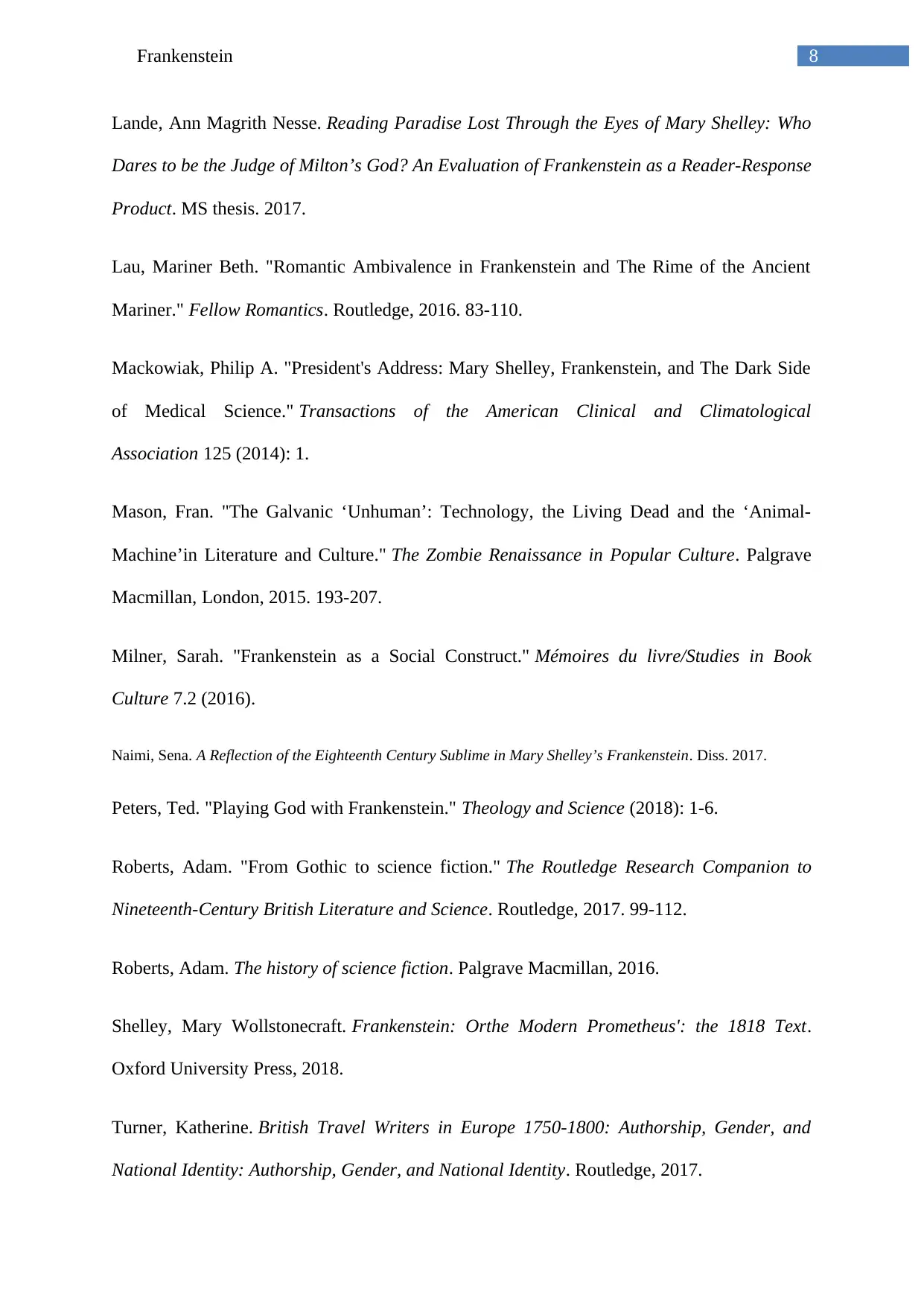
8Frankenstein
Lande, Ann Magrith Nesse. Reading Paradise Lost Through the Eyes of Mary Shelley: Who
Dares to be the Judge of Milton’s God? An Evaluation of Frankenstein as a Reader-Response
Product. MS thesis. 2017.
Lau, Mariner Beth. "Romantic Ambivalence in Frankenstein and The Rime of the Ancient
Mariner." Fellow Romantics. Routledge, 2016. 83-110.
Mackowiak, Philip A. "President's Address: Mary Shelley, Frankenstein, and The Dark Side
of Medical Science." Transactions of the American Clinical and Climatological
Association 125 (2014): 1.
Mason, Fran. "The Galvanic ‘Unhuman’: Technology, the Living Dead and the ‘Animal-
Machine’in Literature and Culture." The Zombie Renaissance in Popular Culture. Palgrave
Macmillan, London, 2015. 193-207.
Milner, Sarah. "Frankenstein as a Social Construct." Mémoires du livre/Studies in Book
Culture 7.2 (2016).
Naimi, Sena. A Reflection of the Eighteenth Century Sublime in Mary Shelley’s Frankenstein. Diss. 2017.
Peters, Ted. "Playing God with Frankenstein." Theology and Science (2018): 1-6.
Roberts, Adam. "From Gothic to science fiction." The Routledge Research Companion to
Nineteenth-Century British Literature and Science. Routledge, 2017. 99-112.
Roberts, Adam. The history of science fiction. Palgrave Macmillan, 2016.
Shelley, Mary Wollstonecraft. Frankenstein: Orthe Modern Prometheus': the 1818 Text.
Oxford University Press, 2018.
Turner, Katherine. British Travel Writers in Europe 1750-1800: Authorship, Gender, and
National Identity: Authorship, Gender, and National Identity. Routledge, 2017.
Lande, Ann Magrith Nesse. Reading Paradise Lost Through the Eyes of Mary Shelley: Who
Dares to be the Judge of Milton’s God? An Evaluation of Frankenstein as a Reader-Response
Product. MS thesis. 2017.
Lau, Mariner Beth. "Romantic Ambivalence in Frankenstein and The Rime of the Ancient
Mariner." Fellow Romantics. Routledge, 2016. 83-110.
Mackowiak, Philip A. "President's Address: Mary Shelley, Frankenstein, and The Dark Side
of Medical Science." Transactions of the American Clinical and Climatological
Association 125 (2014): 1.
Mason, Fran. "The Galvanic ‘Unhuman’: Technology, the Living Dead and the ‘Animal-
Machine’in Literature and Culture." The Zombie Renaissance in Popular Culture. Palgrave
Macmillan, London, 2015. 193-207.
Milner, Sarah. "Frankenstein as a Social Construct." Mémoires du livre/Studies in Book
Culture 7.2 (2016).
Naimi, Sena. A Reflection of the Eighteenth Century Sublime in Mary Shelley’s Frankenstein. Diss. 2017.
Peters, Ted. "Playing God with Frankenstein." Theology and Science (2018): 1-6.
Roberts, Adam. "From Gothic to science fiction." The Routledge Research Companion to
Nineteenth-Century British Literature and Science. Routledge, 2017. 99-112.
Roberts, Adam. The history of science fiction. Palgrave Macmillan, 2016.
Shelley, Mary Wollstonecraft. Frankenstein: Orthe Modern Prometheus': the 1818 Text.
Oxford University Press, 2018.
Turner, Katherine. British Travel Writers in Europe 1750-1800: Authorship, Gender, and
National Identity: Authorship, Gender, and National Identity. Routledge, 2017.
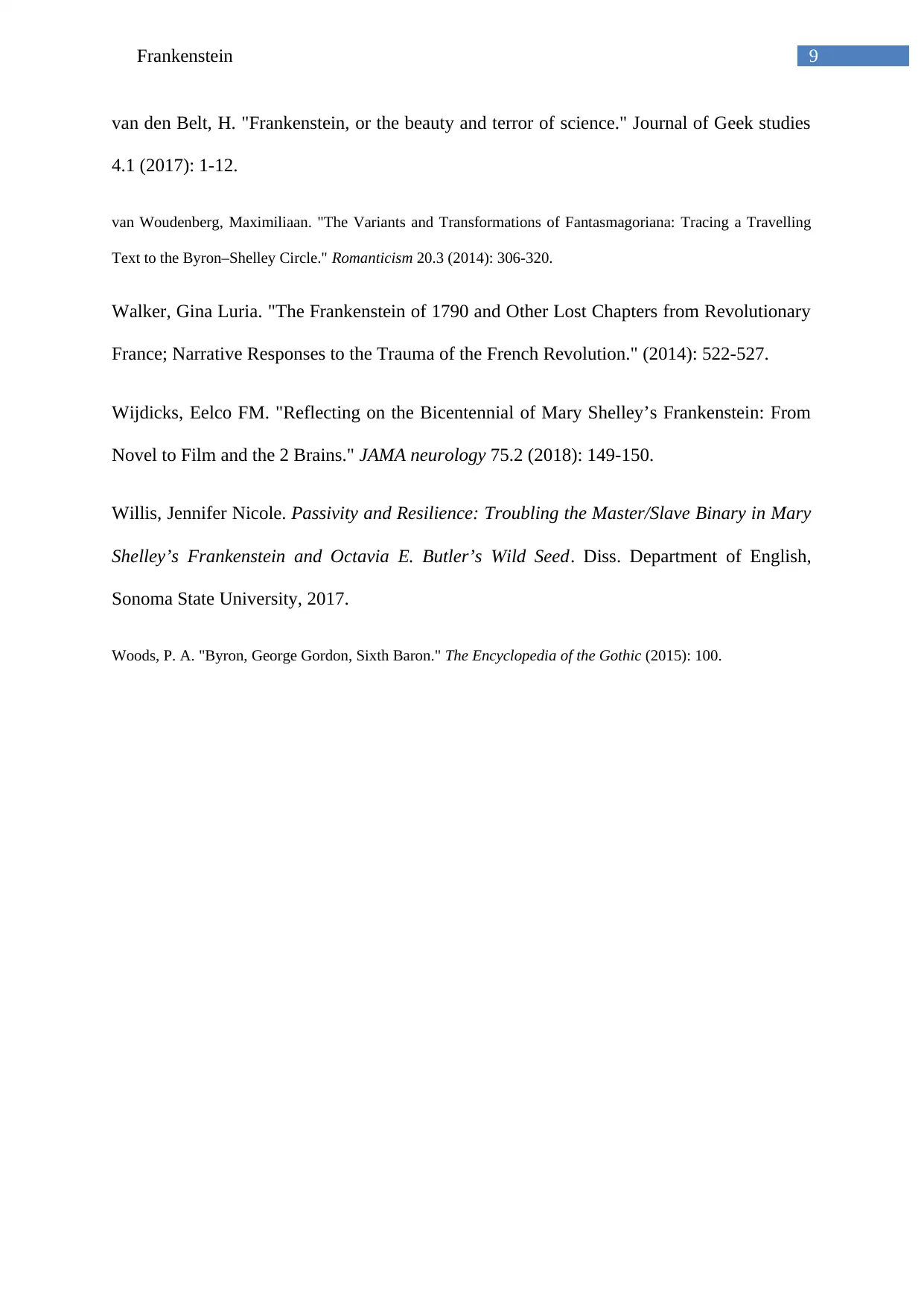
9Frankenstein
van den Belt, H. "Frankenstein, or the beauty and terror of science." Journal of Geek studies
4.1 (2017): 1-12.
van Woudenberg, Maximiliaan. "The Variants and Transformations of Fantasmagoriana: Tracing a Travelling
Text to the Byron–Shelley Circle." Romanticism 20.3 (2014): 306-320.
Walker, Gina Luria. "The Frankenstein of 1790 and Other Lost Chapters from Revolutionary
France; Narrative Responses to the Trauma of the French Revolution." (2014): 522-527.
Wijdicks, Eelco FM. "Reflecting on the Bicentennial of Mary Shelley’s Frankenstein: From
Novel to Film and the 2 Brains." JAMA neurology 75.2 (2018): 149-150.
Willis, Jennifer Nicole. Passivity and Resilience: Troubling the Master/Slave Binary in Mary
Shelley’s Frankenstein and Octavia E. Butler’s Wild Seed. Diss. Department of English,
Sonoma State University, 2017.
Woods, P. A. "Byron, George Gordon, Sixth Baron." The Encyclopedia of the Gothic (2015): 100.
van den Belt, H. "Frankenstein, or the beauty and terror of science." Journal of Geek studies
4.1 (2017): 1-12.
van Woudenberg, Maximiliaan. "The Variants and Transformations of Fantasmagoriana: Tracing a Travelling
Text to the Byron–Shelley Circle." Romanticism 20.3 (2014): 306-320.
Walker, Gina Luria. "The Frankenstein of 1790 and Other Lost Chapters from Revolutionary
France; Narrative Responses to the Trauma of the French Revolution." (2014): 522-527.
Wijdicks, Eelco FM. "Reflecting on the Bicentennial of Mary Shelley’s Frankenstein: From
Novel to Film and the 2 Brains." JAMA neurology 75.2 (2018): 149-150.
Willis, Jennifer Nicole. Passivity and Resilience: Troubling the Master/Slave Binary in Mary
Shelley’s Frankenstein and Octavia E. Butler’s Wild Seed. Diss. Department of English,
Sonoma State University, 2017.
Woods, P. A. "Byron, George Gordon, Sixth Baron." The Encyclopedia of the Gothic (2015): 100.
1 out of 10
Your All-in-One AI-Powered Toolkit for Academic Success.
+13062052269
info@desklib.com
Available 24*7 on WhatsApp / Email
![[object Object]](/_next/static/media/star-bottom.7253800d.svg)
Unlock your academic potential
© 2024 | Zucol Services PVT LTD | All rights reserved.


